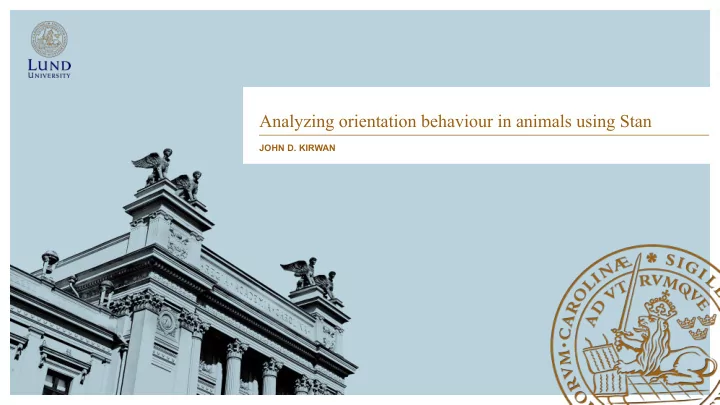

Analyzing orientation behaviour in animals using Stan JOHN D. KIRWAN
With the help of… The Lund Vision Group Dan-E Nilsson Jochen Smolka James J. Foster Anna Stöckl Ullrika Sahlin Richard McElreath (for Statistical rethinking ) All those involved in R , Stan and brms
Directions are everywhere! el Jundi et al. Current Biology 2016
Compass bearings Rachel Muheim et al. PNAS 2016
Time periods
Analysis is unduly rudimentary • Reliance on null hypothesis testing • Assumptions not always met • Less emphasis on effect size, uncertainty
I. How well can millipedes see?
Response to a visual signal by a millipede
Discretize and apply the psychometric function ψ "; α, β, γ, λ = * + 1 − * − . / 0("; α, β) Define threshold by the inflection pt.
Excuse me, sir… ...do you have a moment to talk about Bayes?
Millipedes can resolve a 22º visual signal ! " ~ $ + η 1 − $ − ) η ~ Binomial(n i p i ) logit(p i ) = α + α individual[i] + X i β i λ ~ Beta(8,2) γ ~ Normal(0.2,0.02) β i ~ Normal(0,2) σ ~ t 3 (0,10) α individual[i] ~ t 3 (0,10)
As can velvet worms
II. Do dung beetles orient using polarized light? • Use nocturnal celestial cues to roll their dung ball away in straight course • Sensitive to polarized light cues • Do they use the degree of polarization ? James J. Foster, Lund Vision Group
Tested clustering in experimental arena • Eight treatments: from almost zero to total polarization • Released into centre of cylindrical arena • Compare clustering of tracks James J. Foster, Lund Vision Group
Beetles increasingly orient with more polarization
III. How well do moths track flowers? Which senses are important? At what speed? Night vs. day?
Tracked responses to a robotic flower • Treatments: – Different flower frequency (Hz) – Bright vs. dim light – Antennae condition • Outcome is complex! – ρ and θ on unit circle Stöckl et al. Phil Trans B. (2017)
Differences in flower tracking among moths Gain ( ρ ) Phase ( θ ) Anna L. Stöckl et al. Phil. Trans. R. Soc. B 2017
Phase change with multiple predictors • Both mean and concentration of phase angles vary • Model both elements of complex outcome?
Summary • Bayesian multilevel modelling facilitates getting the most from directional data • Sensory studies benefit from: – multiple effects incl. random effects – more appropriate models – expressing effect size & uncertainty • Stan/brms makes this possible!
Recommend
More recommend